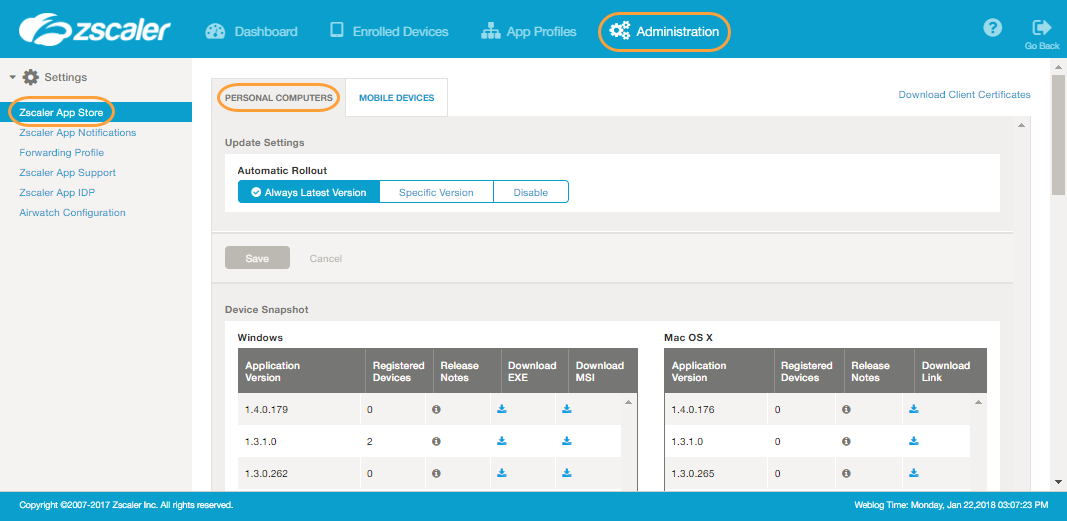Zscaler Mac
Zscaler is a global cloud-based information security company that provides Internet security, web security, next generation firewalls, sandboxing, SSL inspection. +3 - saab - That was very nasty. Use the Zscaler Analyzer app to analyze the path between your location and the Zscaler Enforcement Node (ZEN), or to analyze the time it takes for your browser to load a web page, so the Zscaler Support team can detect potential issues. The app performs an MTR (Z.
Zscaler Mac Download
The figure below shows activity for a user’s device “gatewaymacaddress”. This is the advertised MAC address of the gateway interface. The user’s MAC address changes often, and a “NA” response correlates with page load time spikes and connection losses. Figure 6: Intermittent slowness/outages is affecting all applications. Zscaler Client Connector, formerly Zscaler App (Z App), enforces security and policy control for millions of devices worldwide The challenge of enforcing secure mobile access The number of BYOD and managed devices being used for work continues to grow each year. The Zscaler App for iOS includes both Zscaler Internet Access and Zscaler Private Access modules. Mobility has raised business productivity, but it’s brought its share of issues, as well. One of the biggest challenges is the need to provide complete, consistent security across devices that you may not own. The majority of web tr.
Creating a Zscaler Package
I normally use the Packages software to create a PKG file. The PKG can be used with the CMAppUtil tool to create a CMMAC file---then I import the CMMAC into SCCM. This gives me the ability to automate the installation of Zscaler using a specific policy configuration.

Step 1
In Packages, copy the Zscaler-installer.app into Payload > /Users/Shared/zscaler
Step 2
Create a simple script (save as script.sh):
sudo sh '/Users/Shared/zscaler/Zscaler-osx-2.2.4.0-installer/Contents/MacOS/installbuilder.sh --cloudName YourCloudName --policyToken YourCustomToken2B12343631234465612D234264322B343733372E393166322E636164323564643838411234
--strictEnforcement 1 --useDomain YourDomain.com' -target CurrentUserHomeDirectory -verbose > /Users/Shared/zscaler/log.txt
Step 3
In Packages, copy the script.sh to Scripts > Post-installation option.
Step 4


Build package.
Packages creates your-package.PKG file.
Step 5
With the PKG, you can now use the Microsoft CMAppUtil tool to generate the CMMAC file.
* Be careful with the CMMAC creation process. Sometimes other PKGs end up in the package file; remove those before adding to SCCM.
Download Zscaler Application
-->If you work with both Cloud App Security and Zscaler, you can integrate the two products to enhance your security Cloud Discovery experience. Zscaler, as a standalone cloud proxy, monitors your organization's traffic enabling you to set policies for blocking transactions. Together, Cloud App Security and Zscaler provide the following capabilities:
Uninstall Zscaler Mac
- Seamless deployment of Cloud Discovery - Use Zscaler to proxy your traffic and send it to Cloud App Security. This eliminates the need for installation of log collectors on your network endpoints to enable Cloud Discovery.
- Zscaler's block capabilities are automatically applied on apps you set as unsanctioned in Cloud App Security.
- Enhance your Zscaler portal with Cloud App Security's risk assessment for 200 leading cloud apps, which can be viewed directly in the Zscaler portal.
Prerequisites
- A valid license for Microsoft Cloud App Security, or a valid license for Azure Active Directory Premium P1
- A valid license for Zscaler Cloud 5.6
- An active Zscaler NSS subscription

Deployment
In the Zscaler portal, do the steps to complete the Zscaler partner integration with Microsoft Cloud App Security.
In the Cloud App Security portal, do the following integration steps:
Click on the settings cog and select Cloud Discovery Settings.
Click on the Automatic log upload tab and then click Add data source.
In the Add data source page, enter the following settings:
- Name = NSS
- Source = Zscaler QRadar LEEF
- Receiver type = Syslog - UDP
Note
Make sure the name of the data source is NSS. For more information about setting up NSS feeds, see Adding Cloud App Security NSS Feeds.
Click View sample of expected log file. Then click Download sample log to view a sample discovery log, and make sure it matches your logs.
Investigate cloud apps discovered on your network. For more information and investigation steps, see Working with Cloud Discovery.
Any app that you set as unsanctioned in Cloud App Security will be pinged by Zscaler every two hours, and then automatically blocked by Zscaler. For more information about unsanctioning apps, see Sanctioning/unsanctioning an app.
Next steps
If you run into any problems, we're here to help. To get assistance or support for your product issue, please open a support ticket.